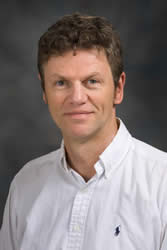
"Gene Paralogs, RNA, and Nonsense," will be presented by Miles Wilkinson at 4 p.m., March 4 in E103 Beadle Center. The seminar is free and open to the public. Wilkinson belongs to the Sanford Consortium for Regenerative Medicine at the University of California, San Diego School of Medicine.
Gene duplication has been a major evolutionary force that drives the generation and adaptation of species. This process provides an opportunity to encode new functions and redistribute the roles of existing functions. Wilkinson will discuss a gene duplication event that occurred at the dawn of the vertebrate lineage that ultimately yielded a different outcome – functional antagonism.
One product of this duplication event – UPF3B – is a well-studied X-linked gene in mammals that functions in human cognition and is critical for a branch of the nonsense-mediated RNA decay (NMD) pathway. Its autosomal counterpart – UPF3A – encodes an enigmatic protein previously shown to have only trace NMD activity when assessed using an artificial tethering assay. Using loss-of-function approaches both in vitro and in vivo, Dr. Wilkinson's laboratory that UPF3A is actually a potent NMD inhibitor. Genome-wide analysis identified hundreds of mRNAs upregulated by UPF3A. UPF3A requires interaction with the NMD factor, UPF2, to repress NMD, an interaction disrupted by a naturally occurring tissue-specific splicing event.
Conditional knockout mice lacking Upf3a exhibit "hyper" NMD and have defects in embryogenesis and gametogenesis. His laboratory's results suggest that the UPF3A and UPF3B paralogs evolved to act as molecular rheostat to control the magnitude of NMD and thereby regulate the stability of a battery of transcripts important for development.
The Beadle Center is located at 1901 Vine Street. The complete schedule of seminars may be found at http://biotech.unl.edu/.
More details at: http://go.unl.edu/u79i